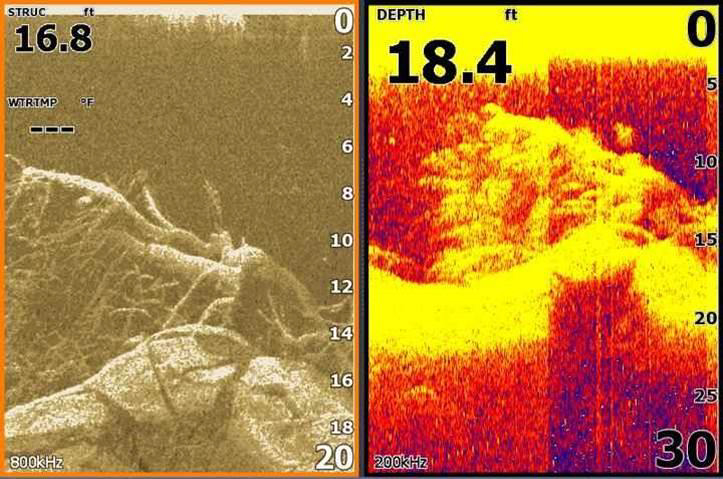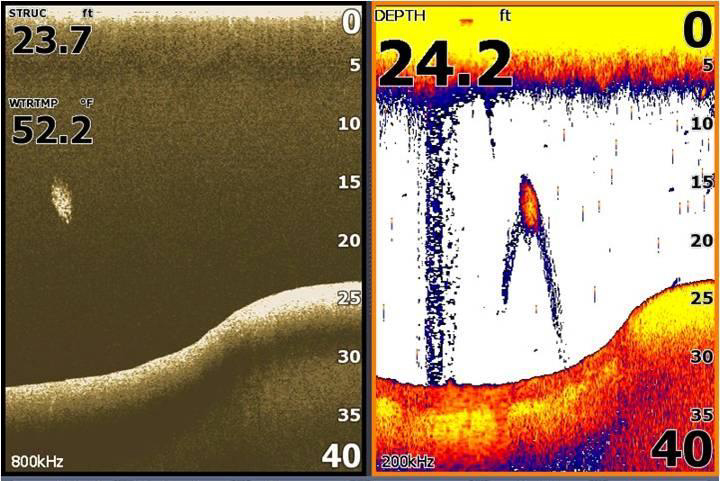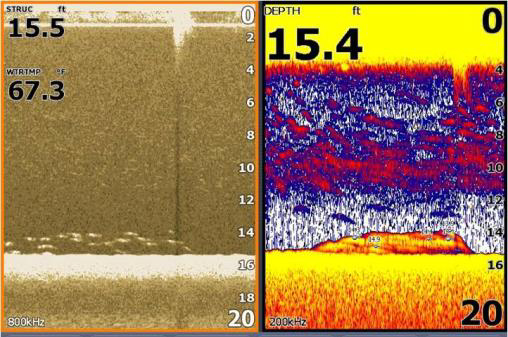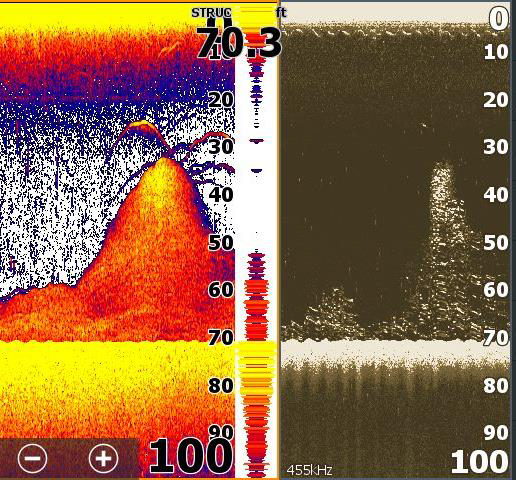Understanding DownScan Sonar
Over the past few seasons DownScan and SideScan sonar imaging have changed the way most anglers search for, and locate fish especially in heavy cover, close to bait or close to the bottom. Due to the higher frequencies used, DownScan sonar will provide a more detailed, almost 3D image of what is below the boat.

The higher definition image we see from the SideScan sonar is created by two factors. First, the cone angle, or area of coverage is MUCH smaller than traditional 2D sonar, resulting in more detail and better target separation. Imagine an 8" paper plate on a table, and let it represent the coverage area of our traditional 2D sonar (red circle). Now place a 12 "school ruler across the middle of the plate. This represents the coverage area of the DownScan transducer (yellow ellipse).
Second, higher frequencies (455-800 kHz) are used by DownScan, again resulting in a more detailed picture with better penetration, separation and detail. The Lowrance LSS-2 transducer uses 3 elements (one down, one left and one right) to create a full picture of the water column (more on SideScan in a later article). DownScan view may also be achieved by adding a HDI transducer to a Lowrance Elite or HDS sonar unit.

Let's start by looking at how SideScan does a much better job of interpreting targets that are close together or very "dense". Here is a picture of a sunken tree. Notice how the 2D sonar on the right side of the screen has a very hard time creating separation and looking "inside" the returns. The left side of the screen is using Lowrance SideScan and shows an entirely different picture. The ability to look "inside" the tree, make out branches and even see fish (inside the yellow circles) makes SideScan invaluable for fishing in structure like weeds, rocks and wood. Can you imagine how much time, and tackle, gets wasted fishing in heavy cover where there are no fish? Now we can do a quick look of cover before we even fish it. Knowing there are fish in the cover, and where they are located leads to better catches by not only fishing where the fish are, but by using a presentation that will work.

Determining if a "mark" is a game fish or tightly schooled bait fish is another huge advantage to using DownScan. Many anglers have spent valuable fishing time fishing where they saw what they thought were game fish marks, but in reality was tightly schooled bait. By being able to penetrate and separate the actual sonar return, DownScan makes it easy to interpret what really is going on below your boat. In the screenshot to the right the DownScan picture on the left screen makes it very easy to see that our "mark" is made up of hundreds of small bait fish and is not a game fish!
Everything you need to know about 2D Fish Arches
One more example of how DownScan can help you catch more fish. In this screenshot we are looking at a school of perch close to the bottom in fairly shallow water marked at about 15 mph. Notice how the traditional 2D sonar cannot completely separate the perch from each other or the bottom? It is very clear on the DownScan screen what we have…a target rich environment and a full bucket of perch that we may have missed without using DownScan!
Hopefully this helps you understand a little better how DownScan works and how to interpret the screen. I get lots of questions about DownScan and the two most often asked are "what do fish look like on DownScan?" and "why don't fish look the same on DownScan as they do on traditional sonar?". Hopefully we can answer those questions.
First, fish on DownScan will show up as bright "dots" and will usually be much shorter than the same mark on 2D sonar. The brightness of the "dot" is related to the intensity of the return (hard bottom and big fish have higher intensity returns) and results in bigger fish and harder bottom being "brighter". The interpretation on this is much easier for me on the grayscale palette shown in the above picture (#6 on Lowrance units). The size of the "dots" on the DownScan is affected by the area of coverage. Remember the "length" of a mark is directly related to how much time the fish spent in the coverage area. Going back to the start of this article, it is easy to see how a fish would spend more time, and create a longer mark in the 2D sonar coverage area (red circle) than in the DownScan coverage area (yellow ellipse).
VIEWING DOWNSCAN ON MULTIPLE UNITS
Here is a great example that one of our Walleye 101 members sent us. It shows a school of bait, probably smelt, being "pushed" by some walleye (notice the brightness of the bait at the top of the spire). The walleye are easy to spot on 2D sonar (I have circled the biggest one in red). Notice it is a thick, yellow mark that tells us it is a game fish, and has some "length" to it showing us it was in the transducer coverage are for a decent amount of time. The same walleye shows up on the DownScan image. The return is bright, so we can assume it is a game fish, but is significantly "shorter" than the 2D mark, signifying that the fish spent a much shorter time in the coverage area of the DownScan transducer, more than likely to the small area of coverage the DownScan transducer has. Running your sonar in side by side, like the picture above, really helps learn how to interpret your DownScan images.
CHECK OUT THE SONAR INTERPRETATION FEATURE COURSESo what does it take to begin to understand your DownScan? The answer is pretty simple..PRACTICE! Get on the boat and just drive and look. If you log your sonar while you are on the water you can use the sonar log as a simulator file on your machine and spend time in your living room playing back, viewing, changing the settings and getting familiar with your sonar returns. We offer two great learning tools here at www.TeachinFishin.com. One is our seminar DVD "Sonar Interpretation" which covers how to set up and interpret 2D, Side and Down scan sonar. The second option is to join Lance on the boat for an on the water electronics class using your boat or his. We will have more information on upcoming dates and locations on the website, so stay tuned.